FAQs
About the website
How is the content on the website organised?
The Data For India website has six verticals at the moment: Population, Health, Living Conditions, Work, Economy and Measurement. All our work is organised under these verticals. You will also find a collection of all the topics covered at the bottom of our homepage.
How can I search for an article or chart on the website?
You can use the search button, available at the top right corner of every page of the Data For India website to search for any of our articles, topics or authors.

How can I see the data behind a chart?
Every chart on the Data For India website contains a menu of options at the bottom right corner which includes:
- A toggle button that lets you switch between chart and table view
- An option to download either the data selected on the chart view, or all of the data behind a particular chart, in
.csvformat
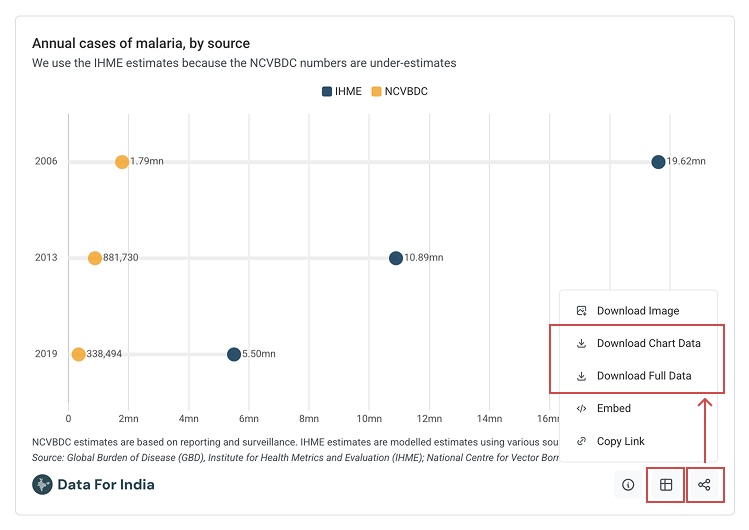
How can I create custom charts on your website?
Currently, you cannot create custom charts on the Data For India website. You can only customise the view for the existing charts by changing the current selection filter, wherever the option is made available.
Many of the charts already published on the website provide you with the options to search or change the geographical region, period of time, or particular indicator that you might be interested in.
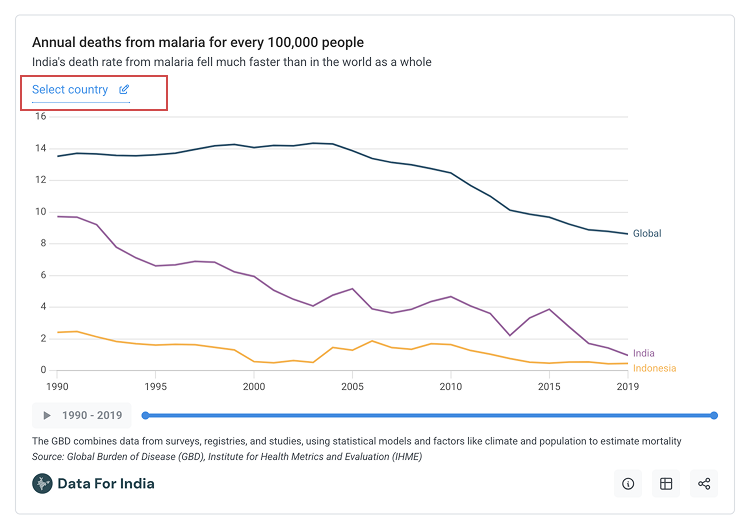
How do you make decisions on what topics are covered?
Data For India aims to be a knowledge resource for readers to be able to answer fundamental questions that they may have about socio-economic issues in India, and our choice of topics reflects these aims.
If there is an area of knowledge you would like to see that is not currently on Data For India, please write to us at info [at] dataforindia.com and we will consider your suggestions.
Do you update the articles published on the website?
Data For India articles aim to be living documents, and we periodically review our work to incorporate newer data and research. Every piece of writing on the website has a time-stamp for the date of publication and for updates. If a piece has been substantially updated, we mark it at the beginning of the piece.
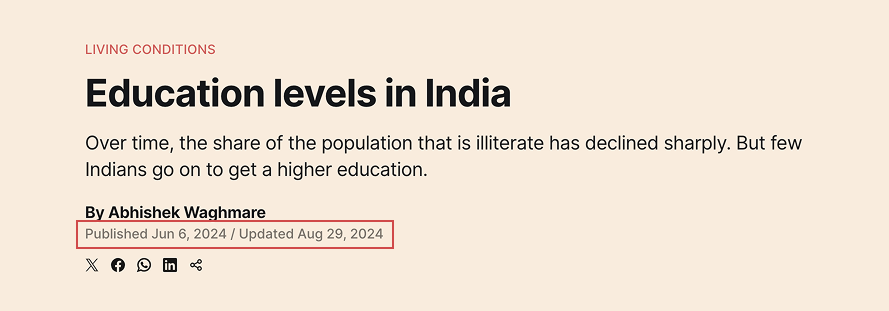
How do I stay updated with your latest work?
You can subscribe to Data For India’s weekly newsletter here, and follow us on all major social media platforms like Instagram, Linkedin and X (Twitter).
How can I trust your work?
All of Data For India’s work mentions the sources of data used and the methodology, and we follow rigorous internal processes to ensure accuracy. We encourage readers to look at the original data sources, and/or use the data for their own work. If you find an error in our work, please contact us at info [at] dataforindia.com.
Using Data For India’s work
How is your work licensed?
Data For India’s work is meant to be shared and used widely. Our articles and charts are published under the Creative Commons Attribution 4.0 License (CC-BY 4.0) and can be freely shared. You do not need to seek our permission to reuse our work; you just need to provide credit to Data For India and link to the original work on our site.
What are the ways in which I can reuse your work?
You can freely cite Data For India’s articles as a source of information, or quote directly from them. You can republish the articles in print or online, provided that you use the full citation and link, and do not imply that we are contributors to your publication.
Please do not attribute any additional words that were not written by us to Data For India, either in text, headlines or on social media.
You can also use our charts as static images, embeds or links in your work, as long as you do not edit them. To know more about our citation guidelines, please check the Using Our Work page.
How can I use the charts on the your website?
You can use Data For India’s charts as static images, embeds or links in your work, as long as you do not edit them. You could download the chart image from our site and upload it in your work, or use a link, or embed the chart image. For online publications, we encourage you to embed our charts so that interactivity is retained.
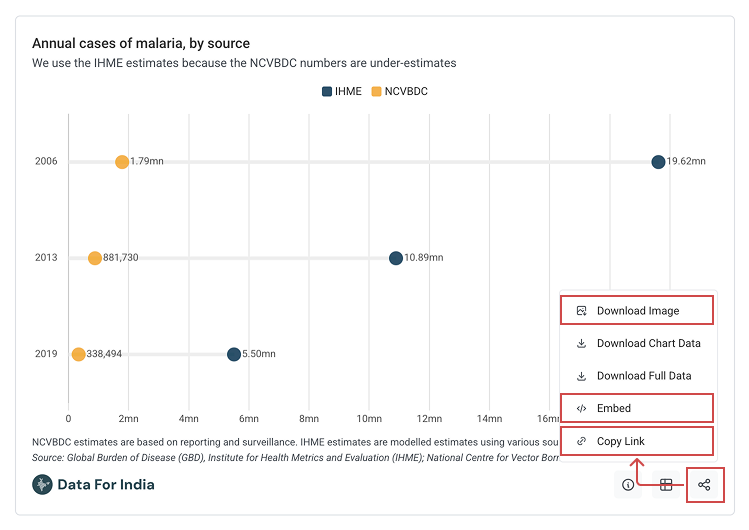
Can I translate your work into another language?
Data For India welcomes translations of our original work, subject to the following:
- Please do share your translations with us for our review
- We will endorse it depending on our ability to review the translation
All translations must include the following statement:
"This is a translation of the original work, produced by [your name]. It is not an official translation by Data For India or the original authors."
Please include a link to the original work following our citation guidelines.
Example of a translation previously reviewed by Data For India: भारत में स्वरोज़गार: मर्ज़ी या मजबूरी? by Puliyabaazi
About the data
What data sources do you use?
Data For India uses public data produced by the Indian national government, and public data from select multilateral agencies. Specifically, this includes the following datasets:
Indian government:
- The Indian Census and its projections
- The National Sample Surveys from the National Statistics Office
- The National Family Health Surveys
- The Sample Registration System and the Civil Registration System of the Office of the Registrar General of India
- Administrative data from national ministries and regulators, typically accessed via the National Data Analytics Platform
- The National Crime Records Bureau
- The e-courts platform for legal data
- The Indian Meteorological Department
Multilateral agencies:
- World Bank World Development Indicators
- United Nations World Population Prospects
- World Health Organization data
- International Labour Organization data
- The Institute for Health Metrics and Evaluation in limited cases
We do not use data produced by private surveyors, think-tanks and NGOs, whether Indian or international, or by Indian state governments.
This is to ensure that the data we use is methodologically rigorous, transparent in its methods, overseen by relevant experts, and public, meaning that it can be verified. It also allows us to be a citable resource for students and academia.
What is your data verification process?
Data For India works only with data from the sources listed above. Wherever possible, we work with raw data from the publication source, and use the published aggregates to recheck our findings. We do not alter the data or indicators in the raw data. We follow established statistical norms while working with the data.
How can I get access to the data on your website?
The bottom right corner of every chart on the Data For India website contains a menu of options that includes:
- A toggle button that lets you switch between chart and table view
- An option to download either the data selected for that chart, or all of the data behind that chart, in
.csvformat
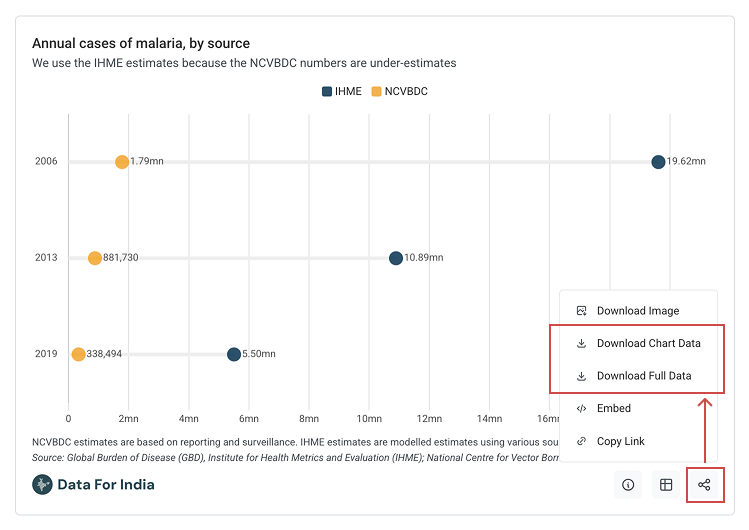
How can I understand the steps taken by you to process the raw data?
Data For India works with raw data from the publication source, and use the published aggregates to recheck our findings. We do not alter the data or indicators in the raw data, and follow established statistical norms while working with the data. If any data is aggregated or renamed for ease of understanding, we state as such in the text, footnotes or chart notes.
For any topics or data sources that require a deeper explanation, Data For India publishes articles under the Measurement vertical explaining the methodology and our decision making process around the data.
Contributing to Data For India
How can I become a contributing writer?
Data For India thanks you for your interest, but we do not currently accept work from non-staffers.
Can I contribute my research data to the website?
Data For India uses only public data produced by the Indian government and multilateral agencies. However, if you have put together a dataset that you think might be useful for us to look at, please contact us at info [at] dataforindia.com.
Do you have any job openings?
Data For India posts job openings on our social media platforms, including LinkedIn.
About the technology
What tools do you use to run the website?
Data For India’s website is built on the Ghost platform, with search driven by Typesense and interactive charts created using the ECharts library.
What tools do you use to create the charts?
Data For India uses an open source JavaScript visualisation library ECharts for creating its interactive charts.
Do you provide an API to access the data available on the platform?
Data For India does not provide any APIs at the moment. The datasets linked to charts can be downloaded using the options available within the share menu on each chart.
About the company
How is your work funded?
Data For India is a private limited company registered in Chennai, India, in June 2023. We fund our work by doing paid data analysis and consulting for think-tanks, universities and private firms. Contact us at info [at] dataforindia.com if you would like to know more about our business offerings.
How can I attend events organised by you?
Data For India makes announcements about upcoming events to our subscribers via email. Choose the “Events” option when you subscribe to Data For India to get updates.
